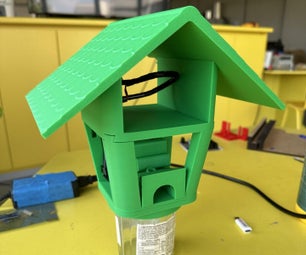Introduction: Make a Breadboard for Electronic Circuits - Papercliptronics
These are STRONG and PERMANENT Electronic Circuits.
For Current Updates visit
papercliptronics.weebly.com
Enjoy Our Step-by-Step Tutorial on Creating Homemade Electronic Circuits.
Step 1: PAPERCLIPTRONICS - Paperclip Circuitry
Step 2: Summary of Different Crimping Methods
Single Crimp, Double Crimp, Transistor Crimping, Microchip Crimping, Spiral Coupling Method, Spiral Slot Method
Step 3: SUMMARY: Paperclip Breadboard = Paperclip Rails + Tape + Elmer's Glue
You will be pleasantly surprised at how STRONG of a HOLD Electrical tape and Elmer's Glue can provide. You must use a good amount of Elemer's Glue over all the edges of the tape. It is a very strong bond.
Step 4: Single Hook Crimp Method
The Single Hook Crimp Method is very easy to achieve.
We simply straighten a small paperclip, make a hook at the end, and then crimp it ontot the leg of the Resisitor using Needle Nose Pliers. The Crimp is VERY STRONG!
Step 5: Double Hook Crimp Method
The Double Hook Shoe Shape is VERY STRONG, SECURE, & CONDUCTIVE.
In order to Fit our pieces in the closed cardboard box, we must CUT the Paperclip down to size.
Step 6: Transistor CRIMPED With Paperclips & Bent Into Hook Shapes for Rails
We CRIMP Paperclips around each Leg of the Transistor.
We BEND the End of those Paperclips into Hook Shapes.
We CONNECT those Hook Shapes to the Paperclip Rails.
Step 7: Switch - Using Magnet (Neodymium)
We ADD a small Paperclip Rail to our Breadboard.
We PLACE our Positive Power Supply Connection onto this new small Paperclip Rail.
We POSITION a normal Paperclip under the small Paperclip Rail.
We USE a Neodymium Magnet on the Positive Rail to MAKE the Connection.
Thus, the power now goes from the small Rail to the Positive Rail at the top, from our new Switch.
NOTE: We used Electrical Tape to hold down our new small Rail. Electrical Tape is very good for temporary designs, but we can also add Elmer's Glue around the edges of the tape to make it more permanent.
Step 8: Paperclip FIXING Components With Short Leads
We can SAVE any Electronic Component using Paperclip Crimping.
We simply CRIMP a Paperclip onto the Short Legs of the Component.
In this example, we MAKE Double Hook Shoe style for the legs, but, if we wanted to use this piece in a breadboard, we would just KEEP the Paperclip Legs straight.
Small Paperclips FIT in Breadboards!
NOW YOU CAN SAVE THOSE 'BROKEN' Electronic Components, using Paperclip Crimping :-)
Step 9: Microchip Crimping With Paperclips - Natural Leg Shape Method
We CRIMP Hook Shapes around each Leg of the Microchip.
In this case, we are using a 555 Timer.
We Keep Space between the legs, so that they NEVER touch.
There are many ways to achieve this spacing.
Step 10: SPIRAL SLOTS Circuit Design Method - Easy Inserting/Removing Components
We MAKE Paperclip Breadboards with Paperclip Spiral Slots
Now we can Insert and Remove our Electronic components easily.
We make SPIRAL SLOTS from Paperclips, that we WRAP onto our paperclip Rails.
The Spiral Slots are Easy to make.
We WRAP a Straight Small Paperclip, around another Straight Small Paperclilp, which we hold with Needle Nose pliers, while we wind the paperclip around and around, with our right hand, to form a spiral slot.
That spiral slot is then wound around the Paperclip Rail, which is a large paperclip.
Step 11: SPIRAL COUPLINGS Circuit Design Method
We USE 90 Degree Paperclip Spiral Slots, for the Angles that our Circuit requires.
Step 12: Papercliptronics Video Tutorials
Here are the Circuits in Action shown in Video
Step 13: LED 6 on a Strip Light
Step 14: Static Electricity Detector Circuit
Step 15: Light Detector Circuit
Step 16: Dual LED Blinking Circuit
Step 17: Water Detector Circuit
Step 18: Make a Homemade Breadboard Using Paperclips - VERY STRONG & PERMANENT CIRCUIT DESIGN METHOD
WATCH the Video Tutorial here to Follow along step-by-step.

Participated in the
Trash to Treasure









